Avicularia
| Avicularia | |
|---|---|

| |
| Avicularia avicularia female | |
| Scientific classification | |
| Kingdom: | Animalia |
| Phylum: | Arthropoda |
| Subphylum: | Chelicerata |
| Class: | Arachnida |
| Order: | Araneae |
| Infraorder: | Mygalomorphae |
| Family: | Theraphosidae |
| Genus: | Avicularia Lamarck, 1818[1] |
| Type species | |
| Aranea avicularia | |
| Species | |
|
See text. | |
| Diversity | |
| 12 species | |
| Synonyms[1] | |
|
Avicuscodra Strand, 1908 | |
Avicularia is a genus of the family Theraphosidae containing various species of tarantulas. The genus is native to tropical Central and South America.[2] Each species in the genus has very distinguishable pink foot pads.
A common myth about tarantulas is that they are adept jumpers, however this has not been observed by researchers and more likely to cause injury to the spider.[3]
Urticating hairs are distinct to new world tarantulas including the avicularia that are attached to the spider's cuticle via a stalk.[4] These spiny, barbed hairs are used as a defense against potential intruders as well as embedded into silk to protect the egg sac.[5] In active defense, the hairs are released by contact with the stimulus and rubbed in. 'Throwing' or flicking hairs towards an intruder has been seen in A. Versicolor.[6]
At least three species of avicularia are threatened by habitat loss and illegal trafficking, due to their popularity as exotic pets. Avicularia avicularia are among the tarantulas most commonly kept as pets for their "stunning" color and size.[2]
Taxonomy[]
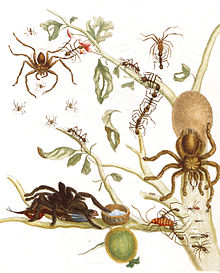
The genus Avicularia was erected in 1818 by Jean-Baptiste Lamarck for species previously placed in Mygale Latreille, 1802, the genus name used at the time for most mygalomorph spiders. One of the species Lamarck included in his new genus was Avicularia canceridea, which included Aranea avicularia, first described by Carl Linnaeus in 1758. Araneologists continued to use the name Mygale, although this had been used for genus of mammals in 1800, so was not available for Latreille to use for spiders. Ausserer in 1871 used Avicularia, but a degree of confusion persisted until a decision of the International Commission on Zoological Nomenclature in 1928 established the correctness of Avicularia, with the type species being Linnaeus' Aranea avicularia in the combination Avicularia avicularia.[7]
Linnaeus' name avicularia is derived from the Latin avicula, meaning "little bird", and refers to a 1705 illustration by Maria Sibylla Merian, showing a tarantula feeding on a bird. The English names "bird spider" and "bird-eating spider" and the German name Vogelspinne reflect the Latin name.[7]
A major review of the genus drastically reduced the number of species recognized, from over 50 to 12, as of March 2017. Some species have been transferred to other genera, with others reduced to synonymy. Yet more names are considered to be doubtful in their application (nomina dubia).[7][1]
Species[]
As of March 2017, the World Spider Catalog accepted the following species:[1]
- Avicularia avicularia (Linnaeus, 1758) (type species) – Venezuela, Guyana, Suriname, French Guiana, Trinidad and Tobago, Brazil, Peru, Bolivia
- Avicularia caei Fukushima & Bertani, 2017 – Brazil
- Avicularia glauca Simon, 1891 – Panama
- Avicularia hirschii Bullmer, Thierer-Lutz & Schmidt, 2006 – Ecuador, Peru, Brazil
- Avicularia juruensis Mello-Leitão, 1923 – Colombia, Ecuador, Peru, Brazil
- Avicularia lynnae Fukushima & Bertani, 2017 – Peru, Ecuador
- Avicularia merianae Fukushima & Bertani, 2017 – Peru
- Avicularia minatrix Pocock, 1903 – Venezuela, Brazil
- Avicularia purpurea Kirk, 1990 – Colombia, Ecuador, Peru
- Avicularia rufa Schiapelli & Gerschman, 1945 – Ecuador, Peru, Bolivia, Brazil
- Avicularia taunayi (Mello-Leitão, 1920) – Brazil
- Avicularia variegata F. O. Pickard-Cambridge, 1896 – Venezuela, Brazil
Transferred to other genera:[1]
- Avicularia affinis (Nicolet, 1849) → Euathlus affinis
- Avicularia aymara (Chamberlin, 1916) →
- Avicularia caesia (C.L. Koch, 1842) → Caribena laeta
- Avicularia diversipes (C.L. Koch, 1842) → Ybyrapora diversipes
- Avicularia dubia →
- Avicularia duplex →
- Avicularia embrithes →
- Avicularia emilia → Brachypelma emilia
- Avicularia epicureana → Brachypelma epicureanum
- Avicularia gamba Bertani & Fukushima, 2009 → Ybyrapora gamba
- Avicularia geotoma →
- Avicularia guyana →
- Avicularia hageni →
- Avicularia helluo → Aphonopelma helluo
- Avicularia hespera →
- Avicularia hirsuta (Pocock, 1901) →
- Avicularia imperatrix →
- Avicularia laeta (C. L. Koch, 1842) → Caribena laeta
- Avicularia lanceolata → Aphonopelma lanceolatum
- Avicularia latens →
- Avicularia magdalena (Karsch, 1879) →
- Avicularia marxi → Aphonopelma marxi
- Avicularia mendozae →
- Avicularia mesomelas →
- Avicularia minax (Thorell, 1894) →
- Avicularia muritelaria (Holmberg, 1876) → (Hentz, 1842) (Filistatidae)
- Avicularia myodes →
- Avicularia obscura →
- Avicularia pallida → Aphonopelma pallidum
- Avicularia palmicola (Mello-Leitão, 1945) →
- Avicularia panamensis →
- Avicularia parva →
- Avicularia parvior →
- Avicularia pulchra (Mello-Leitão, 1933) and Avicularia recifiensis (Struchen & Brändle, 1996) → Pachistopelma rufonigrum
- Avicularia regina (Chamberlin, 1917) →
- Avicularia rustica →
- Avicularia rutilans Ausserer, 1875 → Caribena versicolor
- Avicularia sabulosa → Brachypelma sabulosum
- Avicularia saltator (Pocock, 1903) →
- Avicularia seemanni → Aphonopelma seemani
- Avicularia seladonia → Typhochlaena seladonia
- Avicularia serrata → Aphonopelma serratum
- Avicularia smithi → Brachypelma smithi
- Avicularia sooretama Bertani & Fukushima, 2009 → Ybyrapora sooretama
- Avicularia subvulpina Strand, 1906 →
- Avicularia spinicrus →
- Avicularia steindachneri → Aphonopelma steindachneri
- Avicularia stoica →
- Avicularia tamaulipeca → Clavopelma tamaulipeca
- Avicularia tripeppi →
- Avicularia truncata → Aphonopelma truncatum
- Avicularia vagans → Brachypelma vagans
- Avicularia vellutina →
- Avicularia versicolor → Caribena versicolor
- Avicularia violacea →
- Avicularia wacketi →
- Avicularia zorodes →
Treated as synonyms or as nomina dubia:[1]
- Avicularia ancylochira Mello-Leitão, 1923, synonym of A. avicularia
- Avicularia arabica (Strand, 1908), nom. dub.
- Avicularia aurantiaca Bauer, 1996, nom. dub.
- Avicularia azuraklaasi Tesmoingt, 1996, nom. dub.
- Avicularia bicegoi Mello-Leitão, 1923, synonym of A. variegata
- Avicularia braunshauseni Tesmoingt, 1999, nom. dub.
- Avicularia cuminami Mello-Leitão, 1930, synonym of A. avicularia
- Avicularia detrita (C. L. Koch, 1842), nom. dub.
- Avicularia doleschalli (Ausserer, 1871), nom. dub.
- Avicularia exilis Strand, 1907, synonym of A. avicularia
- Avicularia fasciculata Strand, 1907, nom. dub.
- Avicularia geroldi Tesmoingt, 1999, nom. dub.
- Avicularia gracilis (Keyserling, 1891) → Ischnocolus gracilis, nom. dub.
- Avicularia hirsuta (Ausserer, 1875), nom. dub.
- Avicularia holmbergi Thorell, 1890, nom. dub.
- Avicularia huriana Tesmoingt, 1996, nom. dub.
- Avicularia leporina (C. L. Koch, 1841) → Iridopelma leporina, nom. dub.
- Avicularia metallica Ausserer, 1875, nom. dub.
- Avicularia nigrotaeniata Mello-Leitão, 1940, synonym of A. avicularia
- Avicularia ochracea (Perty, 1833), nom. dub.
- Avicularia plantaris (C. L. Koch, 1842) → Iridopelma plantaris, nom. dub.
- Avicularia rapax (Ausserer, 1875), nom. dub.
- Avicularia soratae Strand, 1907, nom. dub.
- Avicularia surinamensis Strand, 1907, nom. dub.
- Avicularia ulrichea Tesmoingt, 1996, nom. dub.
- Avicularia urticans Schmidt, 1994, synonym of A. juruensis
- Avicularia velutina Simon, 1889, synonym of A. avicularia
- Avicularia walckenaeri (Perty, 1833), nom. dub.
- Species

Avicularia caei male

Avicularia hirschii female
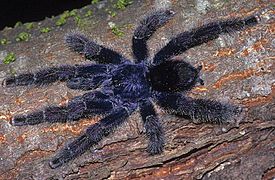
Avicularia juruensis male
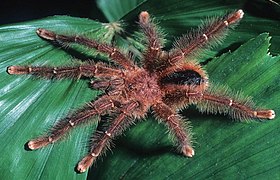
Avicularia lynnae male
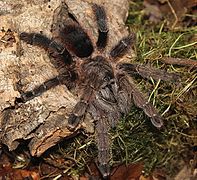
Avicularia merianae female
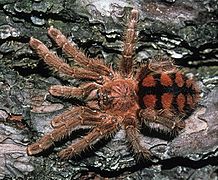
Avicularia minatrix female

Avicularia purpurea female

Avicularia rufa male

Avicularia taunayi female
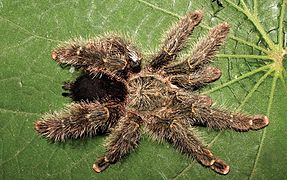
Avicularia variegata female
References[]
- ^ Jump up to: a b c d e f g "Gen. Avicularia Lamarck, 1818", World Spider Catalog, Natural History Museum Bern, retrieved 2017-03-10
- ^ Jump up to: a b Ayroza, Gabriela; Candido Ferreira, Ivan Lavander; Sayegh, Raphael Santa Rosa; Tashima, Alexandre K.; Da Silva Junior, Pedro Ismael (2012). "Juruin: an antifungal peptide from the venom of the Amazonian Pink Toe spider, Avicularia juruensis, which contains the inhibitory cystine knot motif". Frontiers in Microbiology. 3: 324. doi:10.3389/fmicb.2012.00324. ISSN 1664-302X. PMC 3437525. PMID 22973266.
- ^ "Myth: Less common spider myths". Burke Museum. Retrieved 2021-01-15.
- ^ Bertani, Rogério; Guadanucci, José Paulo Leite (Aug 2013). "Morphology, evolution and usage of urticating setae by tarantulas (Araneae: Theraphosidae)". Zoologia (Curitiba). 30 (4): 403–418. doi:10.1590/S1984-46702013000400006. ISSN 1984-4670.
- ^ Kaderka, Radan; Bulantová, Jana; Heneberg, Petr; Řezáč, Milan (2019-11-11). "Urticating setae of tarantulas (Araneae: Theraphosidae): Morphology, revision of typology and terminology and implications for taxonomy". PLOS ONE. 14 (11): e0224384. Bibcode:2019PLoSO..1424384K. doi:10.1371/journal.pone.0224384. ISSN 1932-6203. PMC 6844489. PMID 31710616.
- ^ Bertani, Rogerio (2003). "Release of urticating hairs by A vicularia vcrsicolor (Walckenaer, 1837)(Araneae, Theraphosidae)" (PDF). Bull. Soc. ent. Fr, 44. pp. 29–92. Retrieved 2021-01-15.
- ^ Jump up to: a b c Fukushima, C.S. & Bertani, R. (2017), "Taxonomic revision and cladistic analysis of Avicularia Lamarck, 1818 (Araneae, Theraphosidae, Aviculariinae) with description of three new aviculariine genera", ZooKeys (659): 1–185, Suppl. 1–5, doi:10.3897/zookeys.659.10717, PMC 5345366, PMID 28331414
External links[]
- Theraphosidae
- Mygalomorphae genera
- Spiders of South America
- Taxa named by Jean-Baptiste Lamarck










